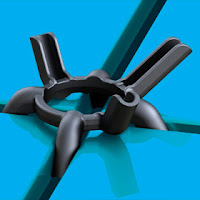TileJax Tile Spacers




The problem with traditional rubber “X” type spacers is getting them out once the tile is installed. I’ve always hated trying to pick the spacers out of the grout lines after the thin set has cured and prior to grouting. If you don’t get them out before you grout then they typically show in the grout lines.
The TileJax spacers stick up above the tile surface so you can grab them easily to remove them. The manufacturer even says you can sweep them up after (I’m a bit skeptical about that seeing that most spacers are pretty tight between the tiles.) The TileJax has seven legs, 4 legs face down in an “X” configuration and 3 legs face up to be used for “T” configurations.
I definitely plan on using these tile spacers on the next tile job I do.
Have any of you tried them? Any comments or feedback?
Recent Posts
Framing Stick Nailer vs Coil Nailer
Which is Better a Stick Nailer or Coil Nailer? Framers have many choices in nailers…
How Many Roofing Nails Per Square of Shingles
Estimating How Many Nails for a New Roof When it comes to estimating materials for…
Composite / PVC Decking – Layout Tips & Advice
Composite / PVC Decking Layout Tips and Advice Composite and PVC decking have really changed…
Benefits of an ERV System (Energy Recovery Ventilator)
Benefits of ERV Systems (Energy Recovery Ventilator) If you're building a new home or doing…
Vermiculite Attic Insulation Abatement
Vermiculite Attic Insulation If your home was built before 1990 there is a chance it…
Nuisance Tripping of AFCI (Arc Fault) Circuit Breakers
Arc Fault (AFCI) Circuit Breakers Tripping Often An arc-fault circuit interrupter (AFCI) or arc-fault detection…
View Comments
Whoever did our kitchen floor tiles left some of those little foam spacers in the corners and yes - they do show.
The thing is, I thought they made a mistake in laying them down flat like that in the first place.
Whenever I've used those little foam crosses for tile spacing I've not laid them down flat but inserted them upright so that one "arm" spaces the tiles, two horizontal arms lay flat on the tile, and the top "arm" pokes up so that I can remove it later.
None that I've ever purchased came with instructions so I guess it's left to the user to interpret their orientation. I went with vertical...
Vertical makes them a lot easier to remove, but when tiling walls, a little harder to line up 4 adjacent tiles. It's still worth doing them vertically, though, just for the ease in removing them. Otherwise you have to resort to a dental pick or the like to get some of them out.
Sounds like a good idea. My friend lays tile. I'll mention it to him.
SteamboatEcobroker
I've tried these out on my subway backsplash. Now I'm not a pro and have done limited tiling before but TileJax seemed much easier and more elegant than X spacers. They take a little getting used to but once you've figured it out, no problem. From my previous experience it seems the X spacers moved around too much when postioning the tile. The TileJax, being larger and more robust stayed in place. Doing corners was simple. Also, they are easy to remove and did not clog up so I can use them again.